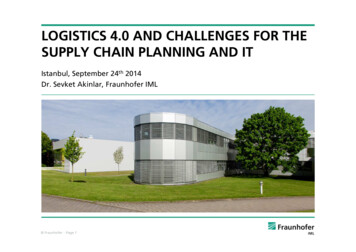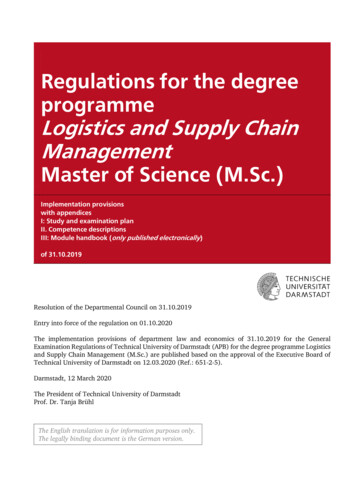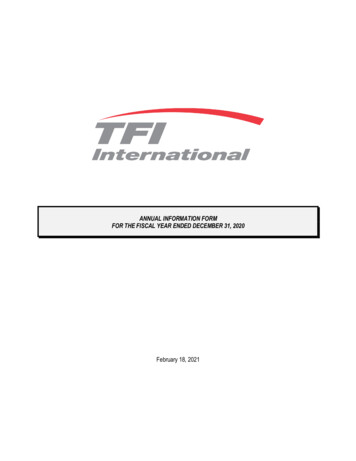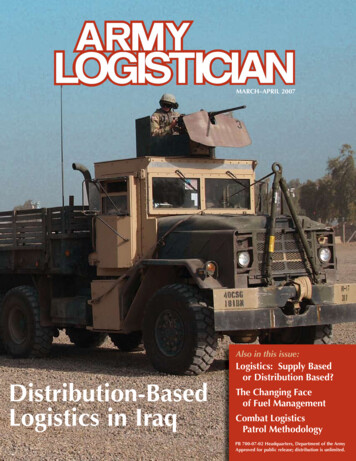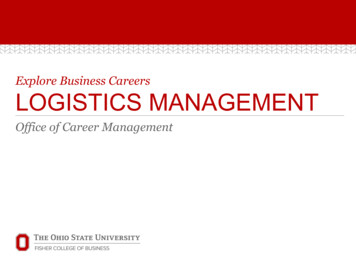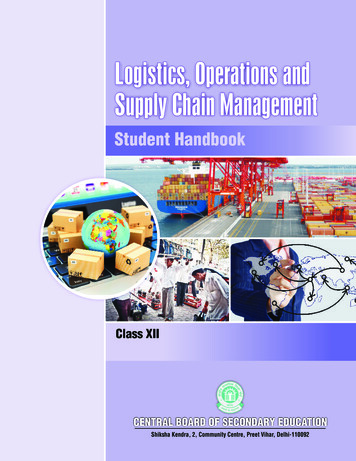
Transcription
Current IssuesSector researchNovember 26, 2015AuthorEric Heymann 49 69 910-31730eric.heymann@db.comEditorLars SlomkaDeutsche Bank AGDeutsche Bank ResearchFrankfurt am MainGermanyE-mail: marketing.dbr@db.comFax: 49 69 910-31877www.dbresearch.comDB Research ManagementRalf HoffmannOriginal in German: October 27, 2015Logistics in Germany: Onlymodest growth in the near termThe logistics sector in Germany is characterised by innovative and diversifiedcompanies as well as very good location factors. There are, however, economicand structural reasons to expect that turnover growth will be relatively moderateover the next few years. Between 2003 and 2008 sector turnover grew by anominal 4.6% per year. Following the recession, that is from 2009 to 2014, thegrowth rate dropped to 3.4% p.a. (while the inflation rate was somewhat lower).Over the next five years average annualised nominal turnover growth is likely tobe more in the range of between 2% and 3%. This would propel sector turnoverthrough the EUR 300 bn barrier.Structurally weaker world trade, only slow economic recovery in Europe and thereluctance to invest among major customer groups in Germany (industry)suggest that the logistics business will record slightly slower growth in future.Stiff competition will remain a typical feature of the sector; this will apply aboveall to simple, easily substitutable services. Germany is a fiercely contestedlogistics and transport market, not least because of its location at the centre ofEurope. Foreign transport companies command a 40% share of the market forfreight conveyed via toll roads in Germany.The logistics sector will remain a focus of state regulation; this is true particularlyof the important transport segment. Policymakers are seeking to reduce and/orlimit the pollutant and CO2 emissions of all modes of transport. In addition, thereare regulations for specific modes of transport, such as truck tolls in the roadsegment or noise-differentiated track access charges for rail services. Thefundamental requirements for policymakers are to retain a sense of proportionand to take into account the conditions in foreign markets with respect tocompetition.Many German logistics firms succeed in reducing the competitive pressure byproviding their clients with sophisticated, customised services (contract logistics,value-added services). Over time the logistics firm becomes ever more closelyintegrated in the customer's value chain. This enables higher margins to beearned and growth potential to be tapped. One challenge for the logistics firmsis to adapt their services to the increasing digitalisation and further automationof their customers' production processes (Industry 4.0, internet of things). Thismay compel them to make major investments in their own technologicalequipment or staff training.It is obvious that not all companies in the logistics segment have access to theexpertise or financial resources to supply these market segments. Jointventures between smaller firms could provide a solution, but ultimately a greaterqualitative differentiation between the firms in the logistics sector is likely.
Logistics in GermanyTurnover gradually approaching theEUR 300 bn threshold1The logistics sector as such is less clearly defined in the official statistics thanother service sectors such as retailing or traditional areas of manufacturing. The“transportation and storage” sector of the service industry howeverencompasses all the activities that are commonly covered by the term “logistics”(transport, transshipment and storage of goods and related services such as theforwarding business or the operation of freight centres, ports and otherinfrastructure facilities).Turnover* in the transportation and storagesector**, DE, EUR bn30025020015010050003 04 05 06 07 08 09 10 11 12 13 14 15 16* The calculation is based on the structural survey in theservice sector for 2013. The other readings were based ongrowth rates from the short-term surveys. Discrepancieswith previous turnover figures from the structural statisticsare the result of differing statistical definitions. The readingsfor 2015 and 2016 are Deutsche Bank forecasts.** Nearly 20% of turnover is generated from services forprivate clients.Sources: Federal Statistical Office, Deutsche BankResearchIndustry cycle major driver oftransportation and storage2Real manufacturing output and nom. turnover in thetransportation/storage sector, sa, DE, Q11401301201101009003 04 05 06 07 08 09 10 11 12 13 14 15Manufacturing sectorTransportation and storageSources: Federal Statistical Office, Deutsche BankResearchTransportation business leads the wayTurnover split in the transportation and storagesector, Germany, 2013, %7.910.340.510.930.3Warehousing and support activities fortransportationLand transport and transport via pipelinesWater transportPostal and courier services1. Logistics in Germany: Muted performance in 2015/163Turnover of the transportation and storage sector in Germany reached nearlyEUR 290 bn in 2014. The sector provided employment for around 2 millionpeople. By comparison, the automotive industry (including suppliers) in1Germany generated turnover of EUR 270 bn and employed nearly 740,000people in 2014. The transportation and storage sector registers the highestabsolute turnover of the (predominantly) business-related services. Almost 20%of turnover in the transportation and storage sector is however generated fromservices for private clients; these are dominated by local public transport and airtravel. In some cases it is difficult to draw a line between business-related andpersonal services. In the aviation segment, for instance, passenger aircraft arealso used to transport air freight.The biggest segment in the transportation and storage sector is “warehousingand support activities for transportation”, which is dominated by forwardingcompanies. In second place comes land transport (including transport viapipelines), with road freight again generating the largest share of turnover.Only muted turnover growth of lateTurnover in the transportation and storage sector grew only minimally in the lastfew years. From 2012 to 2014 the average increase in turnover was a mere1.3% per year. The segment thus performed worse during this period than otherbusiness-related services. One important reason for the limited growth wasprobably that domestic industrial output has barely increased over the periodstated. Traditionally, industry has been the most important economic driver ofthe logistics sector. That is why industrial output and turnover in thetransportation and storage sector basically follow a similar cyclical pattern.Between 2012 and 2014 logistics came under additional pressure from bothdomestic investment activity (above all investment in plant and machinery) andGermany's external trade rising only less than average on a long-termcomparison. This weighed on new order intake at logistics firms.The worst performing individual segment of the transportation and storagesector between 2012 and 2014 was water transport services, which isdominated by sea and coastal transport. In 2012 in particular nominal turnoverfell by some 10%. Global sea and coastal water transport is still characterisedby overcapacities and low freight and charter rates. In addition, it is feeling theimpact of global trade growth that is low on a long-term comparison (seechapter 2). Prior to the year of recession 2008/09, by contrast, water transporthad regularly sparkled by posting particularly large increases in turnover.In the other segments of the transportation and storage sector there were noparticularly positive or negative outliers in the past three years. From 2012 until2014, average nominal turnover growth ranged between 1.5% p.a. in thewarehousing and support activities for the transportation segment and 2.3% p.a.in the postal and courier services segment. No other segment apart from seaAir transport1* Segment dominated by forwarding companiesSource: Federal Statistical Office2 November 26, 2015This turnover figure refers to the statistical definition according to so-called functional operatingunits. Based on the “facilities” the turnover of the automotive industry in Germany in 2014 cameCurrent Issues
Logistics in GermanyLogistics growth below average since20114Nominal turnover in services sectors and realmanufacturing output, DE, % yoyand coastal water transport has had to suffer a nominal decline in turnover since2012.Employment in the transportation and storage sector has risen steadily since2010 at an average of more than 2% per year. The increase in employmentduring this period was thus slightly lower than for all business-related services( 3% p.a.), but much higher than the increases prior to the year of recession2008/09. It is pleasing that the number of corporate insolvencies in the sectorsince 2009 has fallen steadily and was nearly below its 2009 level of 29%.151050-5-10Economic outlook for logistics: Mixed signals-15-2004 05 06 07 08 09 10 11 12 13 14Selected business-related service segments*Transportation and storageReal manufacturing output* Includes following segments of the service sector:transportation and storage (NACE code H), information andcommunication (J), professional, scientific and technicalservices (M) as well as administrative and supportservice activities (N).Sources: Federal Statistical Office, Deutsche BankResearchGrowth momentum only minimal forseveral years5Nominal turnover in individual segments of thetransportation and storage sector, DE, % yoy20151050-5-10-15-20-25060708091011121314Air transportLand transport and transport via pipelinesWater transportPostal and courier servicesWarehousing and support activities fortransportationSource: Federal Statistical OfficeManufacturing output trending sideways6Output and new order intake in manufacturingsector, DE, sa, moving average, 2010 100120110The German economy is doing well. We currently forecast that German GDP isset to rise by 1.7% in 2015 and by no less than 1.9% in 2016 in real terms(2014: 1.6%) – despite numerous economic and geopolitical risks inside andoutside Europe. Private consumption should be a key growth driver in bothyears. It is likely to rise by 2% in 2015 and by 1.8% in 2016 in real terms andthus grow on average nearly twice as fast as the long-term comparison.Stimulus should come from the labour market, which is characterised by highemployment and low unemployment. In addition there are pay increases thatare higher than the long-term average. Furthermore, real income gains resultfrom the currently low mobility and energy prices. Net immigration to Germanyalso contributes to the strong growth in private consumption.This year and next year real investment in fixed assets will contribute to GDPgrowth, but the growth rate will remain only modest. Given the still quite lowcapacity utilisation in many sectors – at least at the European level – companiesare exercising caution in their maintenance investment activity. That is why thedemand stimulus for the logistics sector has been low from this side. Wecurrently forecast that foreign trade, by contrast, will develop somewhat betterin 2015 and 2016 than in the last three years; the relatively weak eurocompared to its long-term average and the gradual economic recovery in theeurozone are supporting factors. The growing volume of trade with majorEuropean and several non-European partner countries (primarily the US in2015) is accompanied by a higher demand for transport, storage andtransshipment services. However, German exporters are feeling the impact ofthe lower growth and the recession in several emerging markets (China, Russiaand Brazil); so exports to these countries will decline in 2015.Developments in domestic industrial production are particularly important for theeconomic performance of the logistics sector. We expect real growth indomestic industrial production of 0.5% in 2015 and stagnation in 2016. Businessexpectations in the manufacturing sector in the last few months were only just inpositive territory. Capacity utilisation fell in Q2 and Q3 2015, but recoveredslightly at the start of Q4. With growth in industrial output of (at best) 0.5% theindustry share of total gross value added would fall in 2015 and 2016. Germanindustry has performed well against international competitors in recent years –despite weak demand in western Europe. However, 0.5% real growth inindustrial output is nothing spectacular given that interest rates remain low,energy and commodity prices have fallen and the euro is favourably valuedcompared to the currencies of major trading partners. This also holds for theabove-mentioned domestic investment activity.1009080700708091011Output12131415New ordersSources: Federal Statistical Office, Deutsche BankResearch3 November 26, 2015Current Issues
Logistics in GermanySentiment deteriorating of late7Sentiment in the logistics sector has deteriorated somewhat of lateLogistics indicator, DE, normal level 100If the mixed macroeconomic signals are used as a yardstick, it is certainlyunderstandable that there has been no clear trend in sentiment in the logisticssector in the year to date. In each of the first two quarters of 2015 there was arise in the logistics indicator calculated on a quarterly basis by the Kiel Institutefor the World Economy (IfW) on behalf of the logistics trade associationBundesvereinigung Logistik (BVL). Above all, the expectations components rosesharply during this period. The sentiment of companies may also have improvedbecause the price of diesel fuel in the first months of 2015 was markedly lowerthan the 2014 level. This is bringing relief to the cost side of the importanttransport segment (e.g road freight). In Q3, however, the companies'assessment of both the current situation and also their expectations haddeteriorated ations12131415SituationSources: Bundesvereinigung Logistik, Kiel Institute for theWorld Economy (IfW)Transportation and storage: Belowaverage growth recentlyOnly moderate growth in turnover in 2015 and 20168Nominal turnover, sa, DE, 2010 100120110100908003050709111315Selected business-related servicesegments*Transportation and storage* Includes following segments of the service sector:transportation and storage (NACE code H), information andcommunication (J), professional, scientific and technicalservices (M) as well as administrative and supportservice activities (N).Source: Federal Statistical OfficeSince end of 2008/09 recession steadyrise in employment9The slightly worse sentiment among logistics companies of late tallies with thelatest trend in turnover in the transportation and storage sector. In the first twoquarters of 2015 nominal turnover fell by a seasonally adjusted 0.4% and 1.4%qoq respectively (figures for Q3 are not yet available). It should be noted herethat the sector had reached a high level of turnover at the end of last year.Sector turnover in H1 2015 is thus still 0.9% higher than in the correspondingyear-earlier period. The lowest turnover growth recorded during this period wasin the land transport segment. Low diesel prices may in turn have played a part.After all, the stiff competition in the road freight segment for example may resultin transport firms having to pass on some of the reduction in their fuel costs totheir customers. If the prices of transportation services then fall, this weighs onnominal turnover for the sector.Overall, we expect nominal turnover in the transportation and storage sector torise by around 1% in both 2015 and 2016. This would represent a slowdown ingrowth compared to previous years. Faster growth is mainly prevented by theonly slow increase in industrial output and modest investment activity. Nominalturnover could grow more strongly in 2016, if fuel prices rose appreciably andthese increased costs were to be added to the prices of transportation services.Oil prices are, however, likely to remain relatively low into 2016 on account ofthe plentiful supply of oil. The moderate growth in employment in the sector islikely to continue in the current year and into next year, with the sector alsobenefiting from additional contracts from clients in the manufacturing and othersectors (see chapter 2).Employees in Germany, sa, 2010 100120Road transport dominates the modal split and has gained market share again oflate110100908003050709111315Selected business-related servicesegments*Transportation and storage* Includes following segments of the service sector:transportation and storage (NACE code H), information andcommunication (J), professional, scientific and technicalservices (M) as well as administrative and supportservice activities (N).Source: Federal Statistical Office4 November 26, 2015If we analyse the development of shares of the individual modes of freight traffic(modal split), the dominance of road freight is striking. In 2014 its share oftransport volume (freight volume forwarded) of 83.7% and traffic volume (tonnekilometres, i.e. freight volume forwarded in tonnes multiplied by the distancetransported in kilometres) of 70.9%. The rail freight share of transport volumecame to 8.7%. The rail share of traffic volume was much higher at 17.3%. Thedifference between transport volume and traffic volume is due to the fact thatthe average distance covered on rail freight journeys is usually longer than thatfor road freight; also, more heavy bulk goods (such as coal and ores) aretransported by rail – relatively speaking.It is striking that rail freight has been losing market share again over the last fewyears and will do so again in 2015. The main reason for this in 2014 and 2015 isCurrent Issues
Logistics in GermanyRoad transport dominant10Modal split of freight traffic volume in Germany, %80706050probably the rail journeys lost due to strikes. In addition, road freight isbenefiting this year from the low price of diesel, which is boosting itscompetitiveness relative to rail freight. In the past decade rail freight was stillmanaging to grow slightly faster than other modes of transport and thus gainmarket share. As a result of deregulation new providers entered the rail freightmarket. Competition in this segment intensified. In addition, road freight wasencumbered by new regulatory measures (e.g. truck tolls) and subsequentlyhigh diesel prices. This “rail renaissance” is currently faltering, however.40302. Medium-term growth outlook for logistics intact, but low growthrate – structural challenges looming2010095 97 99 01 03 05 07 09 11 13 15RoadRailInland waterwayPipelinesSources: DIW, Transport Consulting InternationalGermany particularly open compared toother major economies11Degree of openness: Goods exports plus goodsimports relative to GDP, 2014, ces: Eurostat, Deutsche Bank ResearchGermany maintains close trade relationswith the US and China12Exports* of selected EU states to the US and China, USDbn, 2014DEFRUKITES02550CN75US* Deviations from national statistics are possibleSource: IMF5 November 26, 2015100There is a host of reasons to suggest that the logistics sector in Germany canboost its turnover levels in the coming years as well. One factor on the supplyside is the capability of the domestic firms. They range from large groups withglobal operations that are internationally competitive right through to small andmedium-sized firms that focus, for example, on certain regions or product and/orclient-specific logistics services and are successful in their niches.Another advantage that Germany has as a logistics location is its geographicalposition at the centre of Europe. The economic integration of the easternEuropean EU states is not yet complete. The prospect of (even) closer tiesbetween the old and the new EU states and other eastern European statesought to benefit firms in Germany, as they mean increased demand for logisticsservices; of course the economic crisis in Russia is currently acting as adampener in this respect. In the process of EU enlargement eastwards and thederegulation of the European freight market, competition and cost pressureshave of course also intensified, which mainly applies to simple transportservices.Along with its central location in Europe Germany's economic openness alsohas a positive impact on the logistics sector. The share of goods exports andimports relative to GDP is higher in Germany than in any other large Europeancountry. For the German logistics groups operating worldwide it is an advantagethat Germany also entertains very extensive trade relations with economiesoutside Europe. For instance, German exports to the US or China are muchhigher than those of other European countries in absolute terms. Relativelyspeaking, too, the US and China have expanded their shares of German goodsexports in recent years.Polycentric economic structure and high degree of industrialisation arebeneficialLogistics companies in Germany benefit from additional positive location factors.For instance the highly polycentric economic structure – compared to France orthe UK – results in greater demand for logistics services: Germany has a verylarge number of economically strong regions that collaborate closely with eachother. This makes it necessary, among other things, to transport freight betweenthe individual business centres. Germany's high degree of industrialisation is afurther positive aspect. The manufacturing sector's share of total gross valueadded was about 22% in 2013 and thus nearly seven percentage points abovethe EU average.Of prime importance for a functioning logistics sector is a well-developedinfrastructure, which above all applies to transport routes. For many years therehave been complaints from business associations, commissions set up bypoliticians and economic institutes that too little is being invested in Germany'stransport infrastructure. Indeed the degree of modernity of the public transportinfrastructure in the last 20 years has fallen slowly but steadily. The investmentCurrent Issues
Logistics in GermanyGermany has high manufacturing share13Manufacturing share of total gross value added,2013, %DEITEU-28ESFRUK0510152025Source: EurostatRoad infrastructure: Demand has risenfaster than supply14Germany, 1991 1002001801601401201008060in the transport infrastructure has not kept pace with the increase in trafficvolume. Local bottlenecks have been restricting the flow of traffic for manymonths and driving up costs for the freight business and transport companies.The linking of major seaports to the hinterland is progressing only slowly. Thereis widespread agreement that there has indeed been insufficient investment intransport infrastructure. There are, however, differing estimates as to the extentof the shortcomings in public infrastructure. In a report published at the end of2014 Deutsche Bank Research estimated that an additional EUR 5-10 bn per2year needed to be invested in (transport) infrastructure. It is a positive sign thatthe federal government plans to increase expenditure on the maintenance and3expansion of federal highways over the next few years. This ought to bemaintained for the long term. All the same it will probably take a number of yearsbefore the past failures to invest in transport infrastructure have been remedied.Despite the insufficient investment over recent years Germany's transportinfrastructure is still very good by international standards. According to theWorld Bank's Logistics Performance Index (LPI) Germany even earns 1st placein the rankings for the infrastructure criterion. It would be fatal for Germany if its(hitherto still present) advantages with respect to transport infrastructure were tobe put at risk by sustained insufficient investment. After all, a well functioninginfrastructure enables macroeconomic efficiency gains to be made and canmake up for at least some of the shortcomings in other areas (such as labourcosts).Globalisation shifting down a gear or two91 93 95 97 99 01 03 05 07 09 11 13Real net fixed assets (roads and bridges)Real gross investment in fixed assets(roads and bridges)Road transport traffic volumeMotorised individual traffic volumeSources: DIW, Deutsche Bank ResearchGermany back at top of leading logisticslocations15Logistics Performance Index; 1 low, 5 highDENLBEUKSGSENOLUUSThe observations already made in chapter 2 have shown that Germany is anexcellent logistics location. Indeed Germany occupies first place in the abovementioned World Bank LPI ranking taking into account all the criteria. Thanks tothese prerequisites the logistics sector in Germany can probably also boost itsturnover over the medium term. Nevertheless, there are a number of reasons tosuggest that turnover growth will be only moderate in the next few years.One of these reasons, in our opinion, is the structural weakness of world trade,which is likely to persist for some time. Whereas in previous years global tradegrew much faster than global GDP on average, their growth rates haveconverged since 2012. The international division of labour and interconnectionof trade have lost momentum since then. This is due to a variety of factors. Forone, China is currently seeking to alter its growth model. Instead of focusing oninvestment and exports private consumption is supposed to develop into a moreimportant pillar of the Chinese economy. This domestic focus is reducing thestimulus generated for global trade. Another key factor in structurally slowergrowth in global trade is the failure to make progress in liberalising trade at theWTO level. Bilateral trade agreements have become more important in recentyears. These are, however, always merely “second-best solutions”. And even inthat regard only slow progress is being made. Negotiations are frequentlyhampered by political opposition, as shown by the Transatlantic Trade andInvestment Partnership (TTIP) that is currently being negotiated between the EU4and the US. Furthermore, there are currently no singular events on the horizonthat will boost international trade at the regional or even global level. In the firstdecade of this century there were China's accession to the WTO (2001) and EUJP3.63.82014Source: World Bank6 November 26, 2015420124.2234See Rakau, Oliver (2014). Case for higher investment in infrastructure – despite questionable"gap analysis". Deutsche Bank Research. Standpunkt Deutschland. Frankfurt am Main.See Pro Mobilität (2015). Verkehrsetat 2016. Informationen zu den Haushaltsberatungen vonBundestag und Bundesrat. Berlin.See Heymann, Eric et al. (2015). German exporters facing strong headwind despite softer euro.In: Deutsche Bank Research. Current Issues. Focus Germany. Frankfurt am Main. Peters, Heikoand Stefan Schneider (2014). Sluggish German exports – cyclical or structural? In: DeutscheBank Research. Current Issues. Focus Germany. Frankfurt am Main.Current Issues
Logistics in GermanyWorld trade has only grown at samespeed as global GDP recently16% yoy, real1510enlargement (2004). Ultimately the growth in global trade is dampened by thefact that several large emerging markets are currently suffering from economicand (homemade) political problems. As major commodities exporters, Russiaand Brazil feel the impact of low commodity prices. Moreover, they are notcurrently attractive for foreign investors due to the failure to implement domesticpolicy reforms, high inflation rates and exchange rate risks.50Economic recovery in Europe occurring only slowly-5-10-158085909500Global GDP0510World tradeSource: IMFLow commodity prices17The medium-term outlook for the German logistics industry is also beingdampened by what will probably be an only sluggish economic recovery inEurope. There are several countries inside the EU that are growing again notleast thanks to successful structural reforms and are receiving stimulus fromexports (e.g. Spain). In other eurozone countries, by contrast, such reforms areprogressing more slowly (e.g. Italy, France). As such, the eurozone is likely toremain a heterogeneous economic area in terms of its growth dynamics.Ultimately, the continued expansionary monetary policy of the ECB is a sign thatthe eurozone still finds itself in a kind of crisis mode. The high unemployment incertain EU states cannot be eradicated in the short term.2010 100, Germany, EUR basisGerman manufacturing sector reluctant to invest160140In addition to these impediments from the foreign trade side the stimulus for theGerman logistics sector from the domestic economy may also diminish in future.This applies especially to the manufacturing sector in Germany as a major clientto logistics firms. It is striking after all that the manufacturing sector has beenreluctant to invest in Germany in recent years; one exception is the automotiveindustry. Overall, the share of the (less relevant for the logistics sector)investment in research and development as a share of total investment hasrisen, while the investment in physical equipment (e.g. machinery) and above all5in construction has been lower. There are many reasons for this development.There is a danger that industry's reluctance to invest will also erode the growthpotential of the manufacturing sector in Germany over the medium term, aslong-term productivity gains are only possible if the capital stock is renewed.Lower industrial growth – all things being equal – means fewer orders for thelogistics sector.12010080604005 06 07 08 09 10 11 12 13 14 15AgriculturalEnergyIndustrialOverall indexSource: HWWIAuto industry investing extensively18Net fixed asset investment*, DE, EUR uring excl. auto industryAutomotive industry13The wholesale and retail sectors in Germany are also among the importantclient groups of the domestic logistics business. From this side, too, the mediumto long-term demand stimuli for the logistics sector wi
logistics and transport market, not least because of its location at the centre of Europe. Foreign transport companies command a 40% share of the market for freight conveyed via toll roads in Germany. The logistics sector will remain a focus of state regulation; this is true particularly of the important transport segment.

